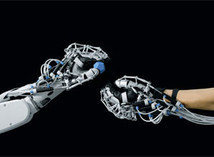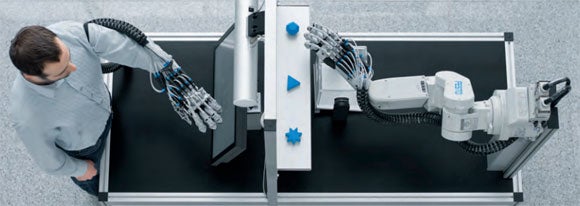/ News

Sophisticated Robotic Hand Also Doubles As A Human Exoskeleton
It may be time to jettison the notion that robots in the future will have grippers or claws for hands. The German robotics company Festo recently unveiled the ExoHand, a sophisticated robotic hand that is capable of the fine motor skills that allows the human hand to have a delicate touch or perform complex manipulations.
The ExoHand comes in two forms: as the extremity of a robotic arm or a wearable exoskeleton glove. The system is designed so that the glove can aid assembly line workers performing repetitive tasks with their hands or be used for the remote manipulation of the robotic arm by a user wearing the glove.
At this year’s Hannover Messe industrial fair, which profiles the world’s most innovative products, the ExoHand came in second for the Best-In-Show Hermes Award.
The motion of a human hand, which consists of 27 bones, is possible because of numerous muscles within the hand and forearm controlled by three different nerves, each of which has components for motor skills and sensory feedback. So mimicking the range of motion capable in a hand requires complementary components in a robotic version. The ExoHand contains eight double-acting pneumatic actuators (the black cylinders in the images) that act as the muscles of the hand, allowing for fingers to pivot and the thumb to rotate toward the palm. In each hand, eight linear potentiometers act as displacement sensors, and 16 pressure sensors provide feedback about the positions, angles, and forces of fingers. The system allows for two-way force feedback, so that a worker remotely manipulating the arm senses what the robot hand “feels”.

The ExoHand was designed for three main purposes: enhance strength and endurance for a user, extend the scope of possible actions of a robotic arm, and secure an independent lifestyle for people with impaired hand function, whether due to age, injury, or disease. The glove could be worn by assembly workers to reduce muscle fatigue and joint stress, for example, or be used in rehabilitation therapy for hand muscles that have atrophied due to injury. In fact, the company’s brochure describes a brain-computer interface that measures EEGs in the patient’s head to open and close the hand, which could help retrain the brain of stroke victims or others who have suffered brain damage.
It’s interesting that Festo opted to design a system in which the robot’s hand and user’s glove look identical, instead of creating a remote controller for the arm. Recently, researchers developed a robotic arm that can be controlled by the mind of a quadriplegic woman, which was possible in part because the areas of the brain that control the motor function of the hand are still active even if communication with the hand has been severed. By designing the ExoHand glove to look identical to the robot hand, users may forget that the robot hand isn’t their own, which will likely aid remote use.
The company has developed a number of other types of robotic arms, such as thePowerGripper modeled after a bird’s beak and the NanoForceGripper, which can handle delicate objects. Festo has also produced robotic arms that are inspired by elephant trunksand the AirArm, which mimics the range of motion possible in the human arm. Along with the company’s efforts, as well as others interested in creating gentler robotic hands as seen in Honda’s Asimo, robot hands are increasingly becoming more human-like.
Festo’s ExoHand pointedly foreshadows the coming convergence of robotics and cybernetic augmentation, and that means people will be able to do more with their lives even as they grow older and succumb to the effects of aging.
Check out the demo that shows how ExoHand can be used for remote operations:
Source: http://singularityhub.com/2012/07/07/sophisticated-robotic-hand-also-doubles-as-a-human-exoskeleton/
/ About us
Founded by Russian entrepreneur Dmitry Itskov in February 2011 with the participation of leading Russian specialists in the field of neural interfaces, robotics, artificial organs and systems.
The main goals of the 2045 Initiative: the creation and realization of a new strategy for the development of humanity which meets global civilization challenges; the creation of optimale conditions promoting the spiritual enlightenment of humanity; and the realization of a new futuristic reality based on 5 principles: high spirituality, high culture, high ethics, high science and high technologies.
The main science mega-project of the 2045 Initiative aims to create technologies enabling the transfer of a individual’s personality to a more advanced non-biological carrier, and extending life, including to the point of immortality. We devote particular attention to enabling the fullest possible dialogue between the world’s major spiritual traditions, science and society.
A large-scale transformation of humanity, comparable to some of the major spiritual and sci-tech revolutions in history, will require a new strategy. We believe this to be necessary to overcome existing crises, which threaten our planetary habitat and the continued existence of humanity as a species. With the 2045 Initiative, we hope to realize a new strategy for humanity's development, and in so doing, create a more productive, fulfilling, and satisfying future.
The "2045" team is working towards creating an international research center where leading scientists will be engaged in research and development in the fields of anthropomorphic robotics, living systems modeling and brain and consciousness modeling with the goal of transferring one’s individual consciousness to an artificial carrier and achieving cybernetic immortality.
An annual congress "The Global Future 2045" is organized by the Initiative to give platform for discussing mankind's evolutionary strategy based on technologies of cybernetic immortality as well as the possible impact of such technologies on global society, politics and economies of the future.
Future prospects of "2045" Initiative for society
2015-2020
The emergence and widespread use of affordable android "avatars" controlled by a "brain-computer" interface. Coupled with related technologies “avatars’ will give people a number of new features: ability to work in dangerous environments, perform rescue operations, travel in extreme situations etc.
Avatar components will be used in medicine for the rehabilitation of fully or partially disabled patients giving them prosthetic limbs or recover lost senses.
2020-2025
Creation of an autonomous life-support system for the human brain linked to a robot, ‘avatar’, will save people whose body is completely worn out or irreversibly damaged. Any patient with an intact brain will be able to return to a fully functioning bodily life. Such technologies will greatly enlarge the possibility of hybrid bio-electronic devices, thus creating a new IT revolution and will make all kinds of superimpositions of electronic and biological systems possible.
2030-2035
Creation of a computer model of the brain and human consciousness with the subsequent development of means to transfer individual consciousness onto an artificial carrier. This development will profoundly change the world, it will not only give everyone the possibility of cybernetic immortality but will also create a friendly artificial intelligence, expand human capabilities and provide opportunities for ordinary people to restore or modify their own brain multiple times. The final result at this stage can be a real revolution in the understanding of human nature that will completely change the human and technical prospects for humanity.
2045
This is the time when substance-independent minds will receive new bodies with capacities far exceeding those of ordinary humans. A new era for humanity will arrive! Changes will occur in all spheres of human activity – energy generation, transportation, politics, medicine, psychology, sciences, and so on.
Today it is hard to imagine a future when bodies consisting of nanorobots will become affordable and capable of taking any form. It is also hard to imagine body holograms featuring controlled matter. One thing is clear however: humanity, for the first time in its history, will make a fully managed evolutionary transition and eventually become a new species. Moreover, prerequisites for a large-scale expansion into outer space will be created as well.
Key elements of the project in the future
• International social movement
• social network immortal.me
• charitable foundation "Global Future 2045" (Foundation 2045)
• scientific research centre "Immortality"
• business incubator
• University of "Immortality"
• annual award for contribution to the realization of the project of "Immortality”.



 LinkedIn
LinkedIn
 LiveJournal
LiveJournal
 Google
Google
 Twitter
Twitter
 Facebook
Facebook
 Я.ру
Я.ру
 ВКонтакте
ВКонтакте
 Mail.ru
Mail.ru